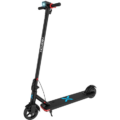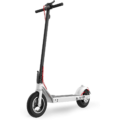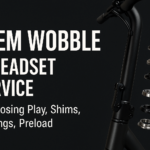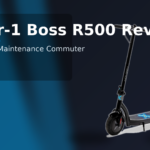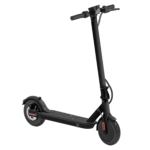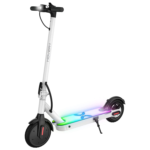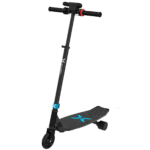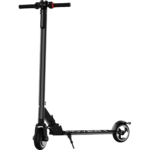- Home
- Scooters
- Electric Scooters
- Hover-1 Ace R450
Hover-1 Ace R450
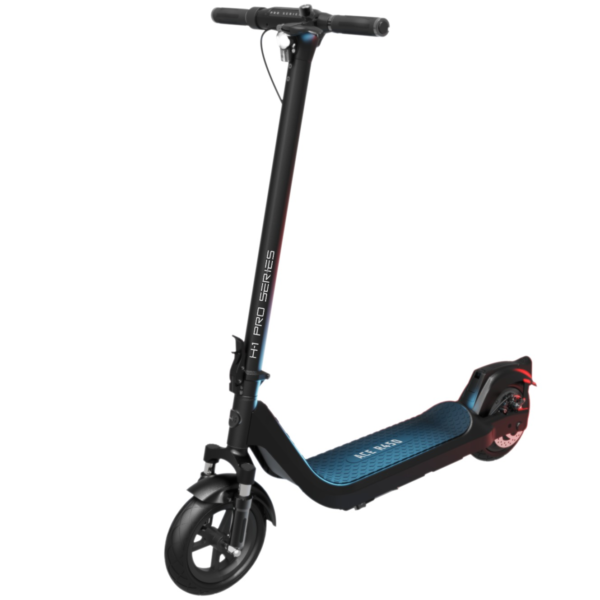


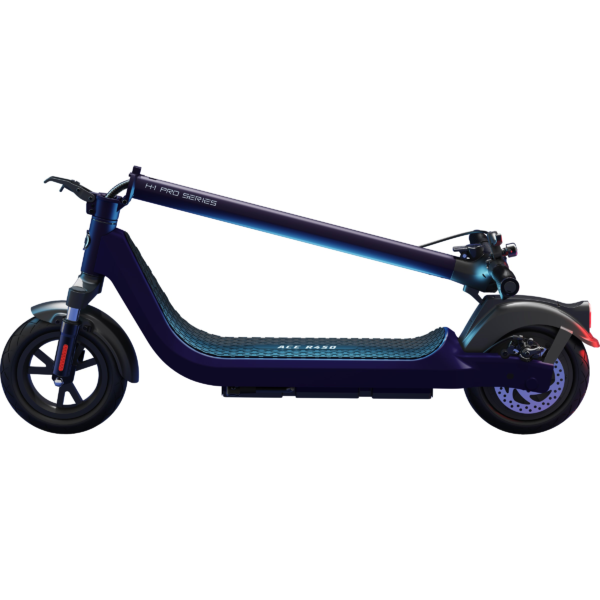
- Battery Range: 25 miles (40 km)
- Top Speed: 20 mph (32 km/h)
- Motor Power: 450 W (rated)
- Weight Capacity: 264 lb (120 kg)
- Charging Time: 8 hours
- Scooter Weight: 41.7 lb (19.0 kg)
PROS
- Up to 20 mph (32 km/h)
- 10″ self-sealing tubeless tires
- Front suspension (dual shocks)
- App lock + cruise control
- Rear disc + electronic braking
CONS
- IP rating not specified
- 8-hour charge time
- Drive position not specified
- Heavier than R350

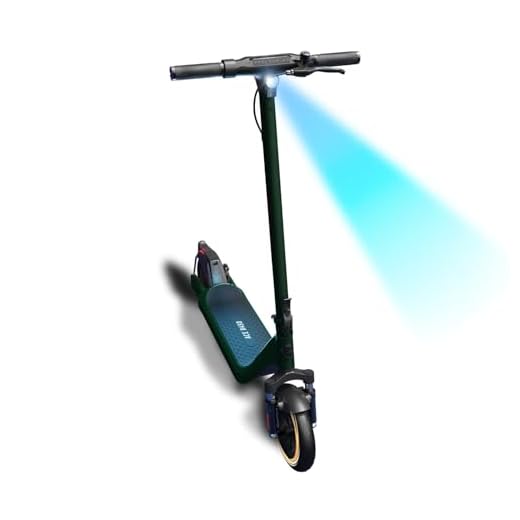
Table of contents
- What Is the Hover-1 Ace R450?
- How the Hover-1 Ace R450 Works
- Key Specifications
- Design & Build Quality
- Performance Fundamentals
- Battery, Range & Efficiency
- Ride Quality & Comfort
- Braking & Safety Features
- Portability & Daily Usability
- Maintenance & Care
- Weather & Seasonal Considerations
- Hover-1 Ace R450 vs Alternatives
- Who the Hover-1 Ace R450 Is (and Isn’t) For
- FAQs
- Glossary
- Final Thoughts
The Hover-1 Ace R450 is a compact, foldable electric scooter designed for short urban trips and last-mile commuting. It blends a 450W rear hub motor with practical safety gear and an easy folding system, so new riders can keep things simple while getting moving fast. Moreover, because it prioritizes stability and predictable control, the Ace R450 suits students, casual commuters, and multi-modal travelers who need a scooter that just works without fuss.
What Is the Hover-1 Ace R450?
The Hover-1 Ace R450 is a lightweight, entry-to-mid scooter built around a rear-drive 450-watt brushless motor and a 36-volt lithium-ion battery. It aims for dependable everyday transportation rather than record-breaking speed. Consequently, you get a reasonable top speed, a stated “up to” range for city rides, and common-sense safety features like a bright headlight, tail/brake light, side reflectors, and a combination of electronic and mechanical braking. Additionally, the frame folds in seconds, which helps on buses, trains, or stairs.
These priorities are straightforward: keep weight manageable, keep operation simple, and keep the ride consistent on typical pavement. Therefore, if you want to avoid surprise maintenance and prefer a scooter that trades outright power for durability and predictability, the Ace R450 is set up to deliver that balance.
How the Hover-1 Ace R450 Works
At a high level, an e-scooter is a rolling battery pack and motor with a deck, a stem, and controls. The Ace R450 is no different, but a few ideas help first-time riders picture what’s happening under the deck.
Motor (rear hub, 450W). Think of the hub motor like a compact, sealed electric wheel. It’s brushless, which reduces wear and noise. Because it sits inside the rear wheel, there’s no chain to oil, no sprockets to align, and almost nothing to adjust.
Controller (the “brain”). The controller meters power from the battery to the motor based on your throttle input and riding mode. It also coordinates electronic braking (regen) and, on many scooters, speed limiters for each mode to match conditions. As a result, power comes on smoothly and predictably.
Battery (36V lithium-ion). The pack stores energy and delivers it at a voltage the motor and controller expect. Capacity determines how far you can ride, while the charger’s current dictates how fast you can refill the tank. In practice, that means routine commutes feel consistent from day to day.
Throttle (thumb-actuated). A thumb throttle lets you roll on power smoothly. Light, early inputs ease you off the line; a firmer push builds speed. Furthermore, because the rear wheel drives, traction at the back stays consistent under power.
Brakes (regen + disc). Electronic regenerative braking slows the rear motor first, which feels gentle at the start. Pulling the mechanical lever adds stronger bite from the rear disc, giving a clear, progressive stop. Consequently, the scooter settles before the harder braking phase arrives.
Together, these systems make the Ace R450 feel intuitive: thumb to go, lever to slow, and the controller handles the rest.
Key Specifications
Below are the official headline details commonly associated with this model. Where makers don’t publish a figure, we note it accordingly. US units come first, with metric in parentheses. Additionally, these specifications are organized into practical blocks for quick reference.
General
| Item | Value |
|---|---|
| Model | Hover-1 Ace R450 |
| Intended Use | Urban commute, campus, last-mile |
| Frame Material | Aluminum alloy |
| Max Rider Weight | 264 lb (120 kg) |
| Riding Modes | 3 (Eco / Drive / Sport) |
| Display | LED speed/battery/mode |
| Kickstand | Yes |
Performance & Power
| Item | Value |
|---|---|
| Motor | 450W brushless rear hub |
| Peak Output | Not stated by manufacturer |
| Top Speed | Up to 18 mph (29 km/h) |
| Hill Climb | Moderate city grades ~7–10% (real-world) |
Battery, Charging & Electrical
| Item | Value |
|---|---|
| Battery | 36V 10Ah (360 Wh) lithium-ion |
| Charger | 42V, 2A |
| Stated Range | Up to 18 miles (29 km) |
| Charge Time | ~5–6 hours |
| Regenerative Braking | Yes (rear hub) |
| Lights | Front LED headlight; rear tail/brake light |
| Reflectors | Side and rear reflectors |
Build & Dimensions
| Item | Value |
|---|---|
| Tires | 10 in (25.4 cm) honeycomb (solid) |
| Braking | Rear disc + electronic (E-ABS) |
| Unfolded Size | ~44.5 × 17.7 × 46.4 in (113 × 45 × 118 cm) |
| Folded Size | ~44.5 × 17.7 × 19.7 in (113 × 45 × 50 cm) |
| Weight | ~35.3 lb (16 kg) |
| Deck Height (approx.) | Low-to-mid stance for stability |
Safety & Control
| Item | Value |
|---|---|
| IP Rating | IP54 (splash resistant) |
| Bell | Mechanical |
| Traction | Rear-wheel drive |
| Speed Limiter Modes | Yes (by riding mode) |
Features & Extras
| Item | Value |
|---|---|
| Cruise Control | Yes (steady throttle hold) |
| Folding Mechanism | Single-step lever with safety latch |
| Grips | Textured, ergonomic |
| Deck Grip | Rubberized pattern |
Warranty & Compliance
| Item | Value |
|---|---|
| Warranty | 90-day limited (typical for category) |
| Compliance | UL-compliant charger; common consumer safety marks (e.g., FCC, RoHS) |
Note: Real-world range and hill performance vary with rider weight, surface, wind, temperature, and tire condition/pressure (if pneumatic; honeycomb solids avoid flats but ride firmer). In short, plan with a margin.
Design & Build Quality
The Ace R450 follows a clean, familiar layout. The stem is straight and confidence-inspiring for new riders, with a centered LED display that’s easy to read in daylight. Because the grips are textured and firm, your hands stay planted when you roll over broken pavement. Additionally, the cockpit keeps buttons close to the thumbs, so you can change modes without shifting your grip.
Down below, the deck provides a stable stance and consistent traction thanks to a rubberized grip pattern. It is long enough for an offset “surfer” stance, which many riders prefer for balance in stops and quick starts. The frame uses aluminum alloy, which keeps weight manageable while resisting corrosion. Moreover, fasteners are conventional hex hardware, so periodic checks are simple.
Fit-and-finish matters on commuter scooters. The Ace R450’s cable routing stays tidy, the lever-based folding joint is direct, and the latch engages with an audible click. That sound is reassuring on a rushed morning. Furthermore, the built-in kickstand holds the scooter high enough to avoid snagging curbs but low enough to flick down with one shoe.
Solid honeycomb tires trade away some plushness for durability. However, that choice suits riders who prioritize a puncture-free routine and minimal upkeep. If your streets are smooth to average, the firmer feel is a fair exchange for not carrying tire levers. In effect, the specifications you see on paper translate into a practical, low-maintenance design.
Performance Fundamentals
Acceleration feel. From a stop, the Ace R450 eases forward predictably. The throttle map is tuned to reduce jumpiness, so you can feed in power in small steps. In Sport mode, it builds speed with more urgency, yet it never surges. Consequently, new riders appreciate that control, especially at crosswalks and trail merges.
Cruising stability. Once at speed, the scooter tracks straight. The low deck helps, since a lower center of gravity reduces steering twitchiness on rough patches. At neighborhood speeds, the chassis remains composed, and the stem stays calm over small seams. Additionally, because the rear wheel drives, traction stays consistent when you add power exiting a corner.
Hill-climb behavior. On typical urban grades around 7–10%, the Ace R450 climbs steadily with a running start. Pace drops on heavier riders and longer hills, which is expected for this class. Therefore, if your route includes a short, punchy rise, choose Sport mode before the climb and keep a smooth throttle. The scooter rewards momentum.
Battery, Range & Efficiency
Manufacturers state “up to” range figures under ideal conditions. In daily use, range depends on weight, wind, elevation, temperature, rolling resistance, throttle habits, and mode choice. Consequently, your results will vary.
Rated vs real-world. The Ace R450’s stated range is up to 18 miles (29 km). Lighter riders on warm, flat routes who cruise in Eco or Drive mode can come close. Heavier riders, colder weather, frequent stops, and Sport mode reduce that number. Additionally, because solid tires don’t deform like air-filled ones, rolling losses can be slightly higher on coarse surfaces, which trims range further.
Rider weight and terrain. As a quick rule of thumb, expect noticeable range changes above 200 lb (91 kg) or on routes with more than 400–600 ft (120–180 m) of elevation gain. However, steady speeds, gentle throttle, and fewer hard stops help stretch miles.
Temperature effects. Lithium-ion cells prefer moderate temperatures. In heat waves, let the scooter cool before charging. In winter, store it indoors and expect reduced range until the pack warms during the ride. As a result, planning with a small buffer is wise.
Charging best practices.
- Let the pack rest for 15–20 minutes before charging after a ride.
- Use the supplied 42V charger on a stable, ventilated surface.
- Avoid full discharges; topping up between 30–80% day to day is gentler on cells.
- For longer storage, leave the battery around half full and check monthly.
These habits reduce stress on the pack and help maintain consistent performance over the seasons. In turn, you’ll preserve the battery’s long-term health.
Ride Quality & Comfort
Tires. The 10-inch honeycomb solids are worry-free on glass shards and staples. You’ll feel sharp edges more than with pneumatic tires, yet the larger 10-inch diameter still rolls smoothly over expansion joints compared with smaller 8.5-inch wheels. Therefore, riders who value zero flat repairs often prefer this setup.
Ergonomics. The cockpit height works for a wide range of adult riders. Because the grips are firm and the deck is low, bodyweight can do more of the suspension work. Bend your knees slightly to hover through rough patches; that small posture tweak pays off. Additionally, the straight bar provides predictable leverage for course corrections.
Stem flex. New riders often notice “stem flex,” a subtle forward-back give under load. On the Ace R450, the stem feels appropriately stiff for the class. It filters high-frequency chatter without feeling vague. Moreover, tightening the folding latch to spec helps maintain that crisp feel.
Vibration behavior. Solid tires transmit more road texture, but the frame and deck absorb the buzz well enough for short-to-medium rides. If you commute over very broken asphalt, consider slightly slower speeds and wider lines around potholes. Even so, because the tire carcass can’t pinch, you won’t risk pinch flats on hard edges.
Braking & Safety Features
Braking system. The Ace R450 combines electronic regenerative braking with a mechanical rear disc. Light lever pulls trigger gentle regen first, which settles the chassis and preserves rear traction. As you pull further, the disc adds firm bite for a confident stop. Consequently, this two-stage feel is easy to learn and smooth in traffic.
Lighting and visibility. The forward LED headlight makes you conspicuous at dusk, while the tail/brake light communicates slowing clearly. Side reflectors boost lateral visibility when crossing driveways and intersections. Nevertheless, it’s smart to add a reflective vest or accessory if you ride after dark often.
Ingress protection. With an IP54 splash rating, the scooter handles light, brief rain and road spray. Avoid standing water, deep puddles, and pressure-washing. In other words, seals resist splashes, not submersion.
Controls and alerts. A mechanical bell adds a quick audible cue on multi-use paths. The display keeps speed and battery visible at a glance so you can manage pace before a hill or headwind. As a result, you’ll ride more proactively.
Portability & Daily Usability
Weight and carry. At around 35.3 lb (16 kg), the Ace R450 is manageable for most adults on stairs and short carries. Because the center of mass sits near the deck, carrying by the stem feels balanced. Accordingly, plan your grip before lifting, and keep the rear wheel behind you on stairs for foot clearance.
Fold mechanism. The single-step lever and safety latch make folding fast and repeatable. Always check for a positive latch click before rolling. If you commute daily, develop a quick routine: fold, lift by the stem, and rest the rear wheel on the first stair to save effort. Additionally, keep the latch interface clean so it continues to close crisply.
Storage. The folded package is slim enough for a closet or desk side. Lay a small mat near your doorway to park after wet rides; that keeps floors clean and reduces corrosion risk from dripping water. Furthermore, storing off the ground helps protect the deck from stray moisture.
Security habits. Use a U-lock or hardened chain through the deck cutout or rear triangle equivalent, and choose sturdy bike racks. Remove easily detachable accessories. Because scooters are light, combine lock type and location choices to deter opportunistic theft. In short, redundancy discourages tampering.
Maintenance & Care
Reliable scooters are still machines. A minute here and there saves headaches.
Quick routine (weekly or every 50–60 miles / 80–100 km):
- Fasteners: Check stem clamp bolts and brake caliper mounts with a hand tool. Snug to spec, never overtighten. Additionally, look for any head play at the folding joint.
- Brakes: Squeeze the lever; confirm strong bite and even pad wear. Adjust cable tension if the lever travel grows. If rubbing develops, re-center the caliper.
- Wheels: Spin the rear wheel; listen for scraping or rubbing. Center the caliper if needed. Consequently, you’ll avoid premature pad wear.
- Contacts: Inspect the charge port cap for debris and a firm seal. After wet rides, wipe it dry.
Every 2–3 months:
- Folding joint: Clean lint and dust, then add a tiny drop of dry lube to the latch pivot (not the mating faces). Re-snug after. Moreover, verify the safety catch engages positively.
- Deck and grip: Wash with a damp cloth and mild soap. Avoid soaking electronic seams. Therefore, you maintain traction without pushing water into seals.
- Firmware/app habits: If your unit supports updates, install only manufacturer releases and avoid beta builds. As a result, you reduce the chance of glitches.
Battery care: Keep the pack between ~30–80% for day-to-day. Store indoors. If you won’t ride for a few weeks, leave it around half charged and check monthly. Consequently, the cells age more slowly.
Because the Ace R450 uses honeycomb tires, you can skip tube patch kits and pressure checks. That alone cuts routine time. In exchange, accept a slightly firmer ride.
Weather & Seasonal Considerations
Rain. IP54 covers splashes, not submersion. Ride slower in wet conditions because painted lines and metal plates get slick. Brake earlier and straighter; let regen start the slowdown, then add mechanical brake. Importantly, avoid deep puddles that could hide sharp edges.
Heat. In hot climates, avoid leaving the scooter in direct sun for hours. Heat soaks the battery and stresses plastics. Park in shade and allow a short cool-down before charging. Consequently, charge times and longevity remain more consistent.
Cold. Expect temporarily reduced range below ~50°F (10°C). Start your ride gently to warm the pack. Because solid tires can feel harder in the cold, keep speeds modest on rough surfaces. In addition, wipe moisture from the deck and bolts after slushy rides.
Storage transitions. After a cold ride, bring the scooter indoors before charging. Let it reach room temperature to protect the cells. In practice, this simple step adds up over a season.
Hover-1 Ace R450 vs Alternatives
The Ace R450 fits the “practical commuter” lane: light enough to carry, quick to fold, and strong enough for neighborhood hills. It excels when your priorities are reliability, small-space storage, and minimal maintenance. Notably, solid tires underpin that promise, since a flat on a tight schedule ruins a morning.
Compared to smaller commuters. Shorter-range, smaller-wheel scooters save a bit of weight, but they feel busier on rough pavement. Additionally, if you want an even lighter, lower-output sibling for short hops, consider the Hover-1 Ace R350; it trades some punch and range for simplicity and portability. The Ace R450’s 10-inch wheels track straighter and roll through street seams more confidently. Therefore, you gain stability even if you carry a few extra pounds.
Compared to performance scooters. Bigger motors and larger packs climb faster and go farther. However, they weigh more, cost more, and often ride stiffer. If your daily trips live inside the Ace R450’s speed and range envelope, you avoid carrying a heavier machine upstairs for little gain. On balance, the simpler platform matches city life well.
Compared to off-road models. Knobby tires and suspension help on dirt, yet add weight and complexity that don’t pay off on smooth streets. For mostly pavement use, the Ace R450’s simpler package reduces upkeep. Consequently, you spend more time riding and less time wrenching.
In short, when you want a durable, commuter-focused scooter with predictable handling and easy storage, the Ace R450’s design choices make practical sense.
Who the Hover-1 Ace R450 Is (and Isn’t) For
Great for:
- Short-to-medium urban commutes with average pavement.
- Students and first-time riders who want a stable learning curve.
- Multi-modal travelers who carry scooters into transit or up stairs.
- Busy riders who value solid, flat-proof tires over plushness.
Maybe not for:
- Very hilly routes where stronger motors shine.
- Long suburban commutes that exceed the stated range.
- Riders who demand plush suspension over low-maintenance tires.
Therefore, if you want a consistent, low-drama ride to work or class, the Ace R450 sits in a sweet spot.
FAQs
1) How fast does the Hover-1 Ace R450 go?
It’s rated up to 18 mph (29 km/h) under favorable conditions. Actual speed depends on rider weight, terrain, wind, and mode. Consequently, your top speed may vary slightly.
2) What is the real-world range?
The stated figure is up to 18 miles (29 km). Expect less on colder days, steeper routes, or with frequent stops and starts. However, smooth throttle and Eco/Drive modes stretch range.
3) Can I ride in the rain?
The IP54 rating covers splashes and light rain. Avoid deep puddles, pressure-washing, and submersion. In addition, slow down sooner and brake in a straight line on wet roads.
4) Does it have cruise control?
Yes. Hold a steady throttle for several seconds and the system maintains speed until you brake or nudge the throttle. As a result, longer straight sections feel more relaxed.
5) What maintenance does it need?
Check fasteners monthly, inspect the rear brake for pad wear and cable tension, keep the folding latch clean, and treat the battery kindly. Because it has honeycomb tires, flat repairs are essentially off your checklist.
6) Is this a good first scooter?
Yes. The power delivery is smooth, the folding system is straightforward, and the controls are intuitive. Therefore, new riders usually get comfortable quickly.
7) Where can I find a concise Hover-1 Ace R450 overview?
You’re reading one. This overview covers design, powertrain, range, brakes, daily use, and care so you can decide if it matches your routine. In short, it’s a one-stop reference.
Glossary
Ah (amp-hours): A measure of battery capacity. Higher Ah means more stored charge at a given voltage.
Wh (watt-hours): Total energy (V × Ah). It approximates potential range better than Ah alone.
Controller: The electronic “brain” that meters power from the battery to the motor based on throttle and mode.
Brushless hub motor: A sealed motor in the wheel that is efficient, quiet, and low-maintenance.
Regen (regenerative braking): Using the motor as a generator to slow the scooter while returning a bit of energy to the battery.
E-ABS: Electronic anti-lock style control that modulates motor braking to reduce wheel lock on slippery surfaces.
Stem flex: Slight forward-back give in the handlebar stem under load. Some flex filters chatter; too much feels vague.
IP rating (Ingress Protection): A two-digit code; “54” means limited dust ingress (5) and protection from splashes (4).
Torque: Rotational force from the motor; more torque improves hill starts and acceleration at low speed.
Rolling resistance: Energy lost as tires deform against the road; solid tires have different losses than pneumatic.
Duty cycle (charging): The ratio of charge to rest. Letting the pack cool before charging reduces thermal stress.
Speed modes: Preset limits for speed and power. Eco saves energy; Sport unlocks higher performance.
Peak power: Short bursts above nominal motor rating during acceleration or hill climbs.
Mechanical trail (steering feel): Geometry that helps the scooter self-stabilize at speed.
Calibration (brakes): Aligning the disc caliper so the rotor runs centered without rub for smooth braking.
Specifications: The published technical details for a model; reading specifications with context helps set realistic expectations.
Final Thoughts
The Hover-1 Ace R450 targets riders who want a straightforward commuter with dependable manners and low daily overhead. Because it pairs a 450W rear hub with honeycomb tires and clear safety features, it keeps the experience predictable and the routine simple. Ultimately, if you value easy storage, low-drama maintenance, and stable urban handling, this scooter earns a spot on your shortlist.
Specifications
General
| Model The Model specifies the exact version or name of the scooter. It helps identify its unique design, features, and specifications within the manufacturer’s product line. Knowing the model makes it easier to compare options, find compatible accessories, or look up support information. | Ace R450 |
| Brand The Brand identifies the manufacturer or company that designs and produces the scooter. A trusted brand is a sign of quality, reliability, and good customer support. Well-known brands often have higher standards for safety, performance, and after-sales service, giving you more confidence in your purchase. | Hover-1 |
| Release Date The Release Date indicates when the scooter model was officially launched on the market. This helps you know how current the design, technology, and features are. A newer release date often means updated components, improved performance, and the latest safety or smart features. | 17 November 2025 |
| Recommended Age Recommended Age indicates the minimum age range that the scooter is designed for, based on safety, size, and ease of use. Following the recommended age helps ensure that riders can handle the scooter’s speed, weight, and controls comfortably and safely. Always check local laws and use protective gear, especially for younger riders. | 14+ |
Performance & Power
| Motor Power (Wattage) What it means: The motor power, measured in watts (W), shows how strong the scooter’s electric motor is. Why it matters: Higher wattage usually means better acceleration, more torque, and improved performance on hills or rough terrain. For example, a 250W motor is good for flat city roads and light riders, while a 500W or 1000W motor provides more power for faster speeds or climbing steep inclines. | 450 W (rated), 750 W (max); Single motor |
| Top Speed The Top Speed indicates the maximum speed that the scooter can reach under optimal conditions. It’s usually measured on level ground with a fully charged battery and an average rider weight. A higher top speed allows you to travel longer distances faster, but always ensure you ride within legal speed limits and your personal comfort zone for safety. | 20 mph (32 km/h) |
| Battery Capacity Battery Capacity refers to the total amount of energy the scooter’s battery can store, usually measured in ampere-hours (Ah) or watt-hours (Wh). A higher battery capacity means you can ride longer distances on a single charge, reducing the need for frequent recharging. Keep in mind that actual range can vary depending on rider weight, terrain, speed, and weather conditions. | 36.5 V 10.4 Ah (380 Wh) |
| Estimated Range per Charge The Estimated Range per Charge indicates the average distance the scooter can travel on a single full battery charge. This range is calculated under optimal conditions, such as flat terrain, moderate speed, and average rider weight. Real-world range may vary depending on riding style, terrain, weather, and load. A longer range means fewer recharges and greater freedom for longer trips. | Up to 25 miles (40 km) |
| Hill Climb Ability Hill Climb Ability describes the maximum incline or slope that the scooter can handle while maintaining stable performance. It’s typically expressed as a percentage or in degrees. A higher hill climb rating means the scooter can tackle steeper hills without losing too much speed or power. Actual climbing performance may vary based on rider weight, battery charge, and terrain conditions. | Up to 17% / 15° |
| Drive System The Drive System refers to how power from the motor is delivered to the wheels. Electric scooters typically use either a hub motor (directly integrated into the wheel) or a chain/belt drive system. A high-quality drive system ensures smooth acceleration, efficient power transfer, and low maintenance. The choice of drive system affects performance, noise level, and overall ride experience. | Not specified |
Charging & Electrical
| Charging Time Charging Time indicates how long it takes to fully recharge the scooter’s battery from empty to 100% using the standard charger provided. Faster charging means less downtime and more time on the road. Actual charging time may vary slightly depending on battery capacity, charger output, and environmental conditions. | Up to 8 hours |
| Battery Type Battery Type refers to the specific technology used in the scooter’s battery, which affects performance, lifespan, weight, and charging time. Most modern electric scooters use high-quality lithium-ion (Li-ion) batteries because they offer a good balance of energy density, durability, and low maintenance. A reliable battery type ensures consistent power delivery and longer riding ranges. | Lithium-ion |
| Removable Battery A Removable Battery means the battery pack can be easily detached from the scooter for convenient charging and replacement. This feature allows you to charge the battery separately, swap it with a spare for extended range, or securely store it indoors in extreme weather. Removable batteries add flexibility and make it easier to keep your scooter powered up wherever you are. | Non-removable internal battery |
| Regenerative Braking Regenerative Braking is an energy-saving feature that converts some of the energy normally lost during braking back into battery power. When you slow down or brake, the motor works in reverse to generate electricity, which helps extend the scooter’s range and improves overall efficiency. This system also reduces wear on traditional brake components, leading to lower maintenance over time. | Not specified |
| Lighting Lighting refers to the built-in front and rear lights that enhance visibility and safety when riding in low-light conditions or at night. Good lighting helps you see the road ahead and ensures that other road users can see you. Many scooters include LED headlights, taillights, and sometimes brake lights or side reflectors for added safety and compliance with local traffic regulations. | Front LED headlight, rear LED taillight |
Build & Dimensions
| Scooter Weight Scooter Weight refers to the total weight of the scooter when fully assembled, including the battery. This affects how easy it is to carry, lift, and store the scooter when not in use. A lighter scooter is more portable and convenient for commuting, especially if you need to carry it upstairs or onto public transport. Keep in mind that a sturdy frame and quality components may add to the weight but also contribute to better durability and ride stability. | 41.7 lb (19.0 kg) |
| Maximum Rider Weight Maximum Rider Weight indicates the highest rider weight that the scooter is designed to safely support while maintaining optimal performance and stability. Staying within this limit helps ensure reliable acceleration, braking, and climbing ability, and it protects the frame, suspension, and motor from excessive strain. Exceeding the recommended limit may reduce performance and increase wear on components. | 264 lb (120 kg) |
| Deck Size Deck Size refers to the dimensions of the scooter’s standing platform. A wider and longer deck provides more foot space, allowing you to stand comfortably and adjust your stance while riding. A well-sized deck improves balance and stability, especially on longer rides or at higher speeds. Compact decks, on the other hand, help keep the scooter lightweight and portable. | Straight T-bar cockpit; deck-mounted kickstand |
| Handlebar Height Handlebar Height refers to the distance from the deck to the handlebars, which affects your riding posture and comfort. An appropriate handlebar height helps you maintain good balance, reduces strain on your back and arms, and makes steering more comfortable. Some scooters have adjustable handlebars to fit riders of different heights, while others have a fixed height for a streamlined design. | Not specified |
| Folding Mechanism The Folding Mechanism describes how easily and securely the scooter can be folded for carrying and storage. A well-designed folding system lets you quickly collapse the scooter into a compact size, making it convenient to transport on public transit, store under a desk, or fit into a car trunk. Look for sturdy latches and safety locks to ensure the scooter stays firmly in place when folded or unfolded. | Central folding hinge with hook latch |
| Dimensions Folded Dimensions indicate the size of the scooter when it’s fully folded. This measurement shows how much space the scooter will take up when stored or carried, making it easier to check if it will fit in your car trunk, under a desk, or in a closet. Compact folded dimensions are ideal for commuters who need to bring their scooter on public transport or store it in tight spaces. | Folded: 47.24 × 20.27 × 21.30 in (120 × 51.48 × 54.1 cm); Unfolded: 47.24 × 20.27 × 47.24 in (120 × 51.48 × 120 cm) |
| Material Material refers to the primary construction materials used for the scooter’s frame and key components. High-quality materials like aircraft-grade aluminum, reinforced steel, or durable composites provide strength, stability, and a lighter overall weight. A sturdy material ensures the scooter can handle daily wear and tear while maintaining safety and performance. | Not specified |
Safety & Control
| Brake Type(s) Brake Type(s) describe the braking systems the scooter uses to help you slow down or stop safely. Common brake types include mechanical brakes (like drum or disc brakes), electronic brakes, and foot brakes. Many scooters combine multiple braking systems for added safety and shorter stopping distances. The type and quality of brakes affect your control, especially when riding at higher speeds or on slopes. | Rear disc + electronic brake |
| Suspension Suspension refers to the system that absorbs shocks and vibrations while riding, providing a smoother and more comfortable ride over uneven or rough surfaces. Scooters may have front suspension, rear suspension, or dual suspension for better shock absorption and stability. Good suspension helps reduce rider fatigue and improves control, especially when riding on bumpy roads or off-road paths. | Front suspension (dual shocks) |
| Tire Type Tire Type refers to the kind of tires the scooter uses, which directly affects ride comfort, traction, and maintenance. Common types include solid (airless) tires, pneumatic (air-filled) tires, or hybrid options. Pneumatic tires offer better shock absorption and a smoother ride on rough surfaces, while solid tires are puncture-proof and require less upkeep. The right tire type helps ensure safe handling and a comfortable ride in different conditions. | 10″ self-sealing tubeless |
| Tire Size Tire Size indicates the diameter and width of the scooter’s tires, which affect ride comfort, stability, and how well the scooter handles different terrains. Larger tires generally offer better shock absorption and a smoother ride over bumps and rough surfaces, while smaller tires keep the scooter lighter and more portable. Choosing the right tire size helps ensure a balance between agility and comfort. | 10-inch |
| Kickstand The Kickstand is a built-in stand that allows you to park your scooter upright when it’s not in use. A sturdy kickstand keeps the scooter stable and prevents it from tipping over, protecting it from scratches and damage. It also makes storing and accessing your scooter more convenient, whether you’re at home, work, or on the go. | Side kickstand |
| Water Resistance Rating Water Resistance Rating indicates how well the scooter is protected against water and moisture, usually shown as an IP (Ingress Protection) rating. This rating helps you understand whether the scooter can handle light rain, splashes, or wet roads without damage. While most scooters are not fully waterproof, a good water resistance rating adds peace of mind when riding in changing weather conditions. Always avoid deep puddles or submerging the scooter to protect its electrical components. | Not specified |
Features & Extras
| Display/Console The Display (or Console) shows important real-time information about your ride, helping you monitor your scooter’s status at a glance. Typical displays show speed, battery level, distance traveled, and riding mode. Some models also include additional features like Bluetooth connectivity, app integration, or backlighting for better visibility at night. A clear and easy-to-read display enhances safety and convenience on every trip. | LED display with speed, battery, trip & error codes |
| Ride Modes Ride Modes refer to the different speed and power settings you can choose to match your riding style or road conditions. Common modes include eco for maximum range and energy efficiency, standard for everyday balance, and sport or turbo for higher speed and stronger acceleration. Switching between ride modes allows you to customize performance, conserve battery, and ride safely in various environments. | Walk / Eco / Drive / Sport (4 modes) |
| Smart App Connectivity Smart App Connectivity lets you pair your scooter with a dedicated mobile app via Bluetooth. Using the app, you can monitor real-time ride stats like speed, battery level, and range, adjust settings such as ride modes or cruise control, lock the scooter for added security, and sometimes receive firmware updates. This feature adds convenience and allows you to personalize your riding experience right from your smartphone. | H-1 Pro Series app (lock, modes, cruise control, updates) |
| Anti-Theft System The Anti-Theft System helps protect your scooter from unauthorized use or theft. This feature can include built-in alarms, electronic motor locks, GPS tracking, or remote locking through a mobile app. A good anti-theft system provides peace of mind when parking your scooter in public spaces, adding an extra layer of security to safeguard your investment. | App lock |
| Cruise Control Cruise Control allows you to maintain a steady speed without continuously holding the throttle. This feature makes longer rides more comfortable by reducing hand fatigue and providing a smoother, more relaxed riding experience — especially on flat, open roads or bike lanes. For safety, cruise control can usually be easily activated or deactivated while riding. | Yes |
| Accessories Included Accessories Included lists the additional items that come with the scooter to enhance your riding experience and convenience. Common accessories may include a charger, kickstand, bell, lights, phone holder, or carrying strap. These extras add value by making your scooter safer, easier to use, and ready to ride straight out of the box. | Scooter, charger, tools, manual |
Warranty & Compliance
| Warranty Period The Warranty Period indicates how long the manufacturer guarantees the scooter against defects in materials and workmanship under normal use. A good warranty provides peace of mind, showing the brand’s confidence in its product quality. Always check what parts are covered, such as the frame, battery, and motor, and follow the maintenance guidelines to keep your warranty valid. | Region-dependent |
| Certifications Certifications confirm that the scooter meets specific safety, quality, and environmental standards set by recognized organizations or regulatory bodies. Common certifications may include CE, RoHS, UL, or other local compliance marks, depending on your region. These certifications ensure that the scooter is manufactured to high standards and is safe and legal to use in your country. | FCC compliance |
Price Comparison




